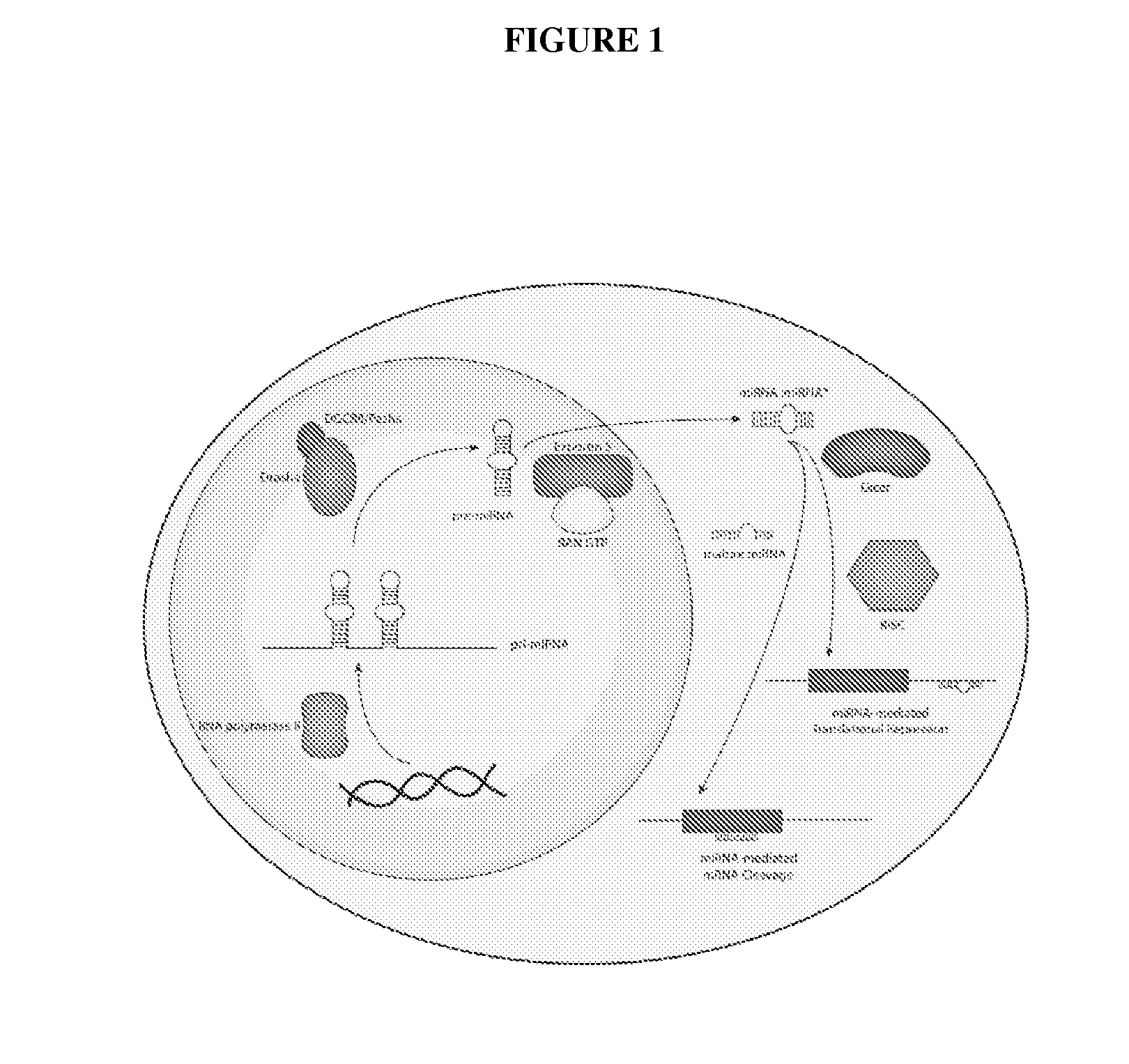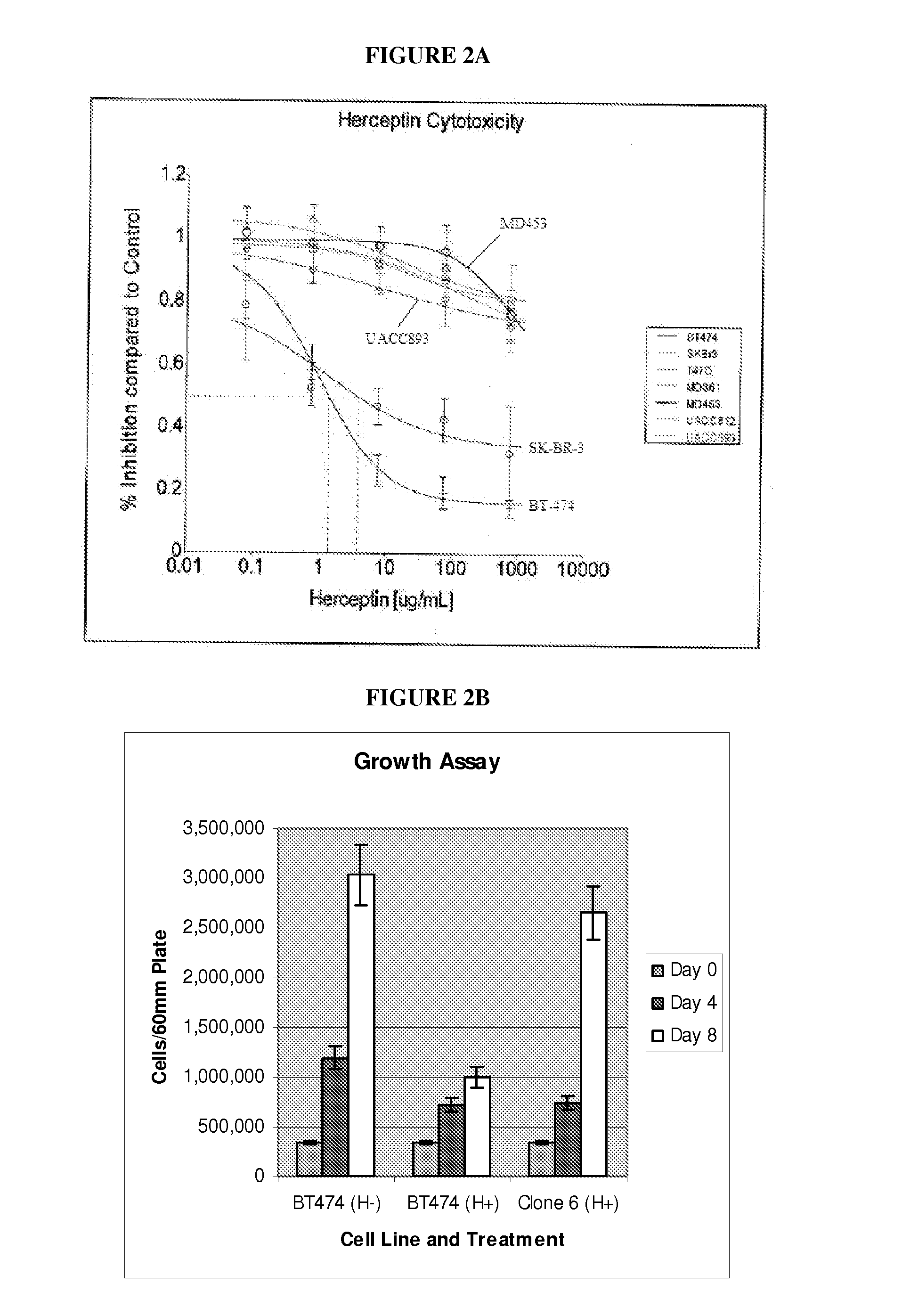MicroRNA Signatures Predicting Responsiveness To Anti-HER2 Therapy
a microrna signature and anti-her2 technology, applied in the field of cancer and molecular biology, can solve the problems of disease progression, resistance and majority of those that respond to therapy, and achieve the effect of predicting tumor responsiveness and patient respons
- Summary
- Abstract
- Description
- Claims
- Application Information
AI Technical Summary
Benefits of technology
Problems solved by technology
Method used
Image
Examples
example 1
Materials and Methods
Cell Culture
[0073]The following breast cancer cell lines were obtained from the Harris Lab at Yale University School of Medicine: BT-474, SK-BR-3, MDA-MB-361 (MD361), MDA-MB-453 (MD453), UACC812, and UACC893 (labeled “parentals,” or untreated). A second stock of BT-474 cells was obtained from the Kute Lab at Wake Forest University (Yakes F M et al. (2002) Cancer Res 62: 4132-4141). These cell lines were maintained in RPMI 1640 with penicillin / streptomycin, 5% L-glutamine, and 10% FBS. Cells were incubated at 37° C. with 5% carbon dioxide. Two additional cell lines that were developed from resistant BT-474 clones were also obtained from the Kute Lab. After treatment with 10 ug / ml of Herceptin for two weeks, these clones were mechanically separated and replaced in media containing 10 ug / ml where they grew as well as the BT-474 cell line in the absence of Herceptin. Herceptin was obtained from the Harris Lab. Cells were kept frozen in liquid nitrogen, suspended in ...
example 2
Herceptin Responsiveness in HER2 Positive Breast Cancer Cell Lines
[0079]For this study, several breast cancer cell lines that highly express HER-2 were obtained. HER2 expression levels in these breast cancer cell lines were analyzed by both IHC and FISH. The response of these HER2 positive breast cancer cells to Herceptin treatment was characterized (FIG. 2A), indicating that, as in tumor tissue, drug response spans a broad spectrum, from complete sensitivity (>50% growth inhibition after 5 days at concentrations above 10 ug / ml) to complete resistance (<5% growth inhibition observed after 5 days at concentrations up to 100 μg / ml). BT-474 and SK-BR-3 cell lines were sensitive while MD361 and MD453 were resistant to Herceptin. The incomplete resistance observed in UACC812 and UACC893 resulted in the exclusion of these cell lines from further analysis. In addition, two resistant clones expanded from BT-474 by treatment with Herceptin for two weeks were obtained. Both growth inhibition ...
example 3
miRNA Profiling in Cell Lines Separates Lines by Herceptin Sensitivity
[0080]Total RNA was harvested from each cell line and microRNA microarray analysis was performed. Cluster analysis identified several miRNAs that differentiated the Herceptin sensitive from the Herceptin resistant cell lines. This included clustering the derived resistant BT474 clone with the Herceptin resistant cell lines. FIG. 4 shows miRNAs with significantly altered expression levels.
PUM
| Property | Measurement | Unit |
|---|---|---|
| concentrations | aaaaa | aaaaa |
| concentrations | aaaaa | aaaaa |
| concentrations | aaaaa | aaaaa |
Abstract
Description
Claims
Application Information
 Login to View More
Login to View More - R&D
- Intellectual Property
- Life Sciences
- Materials
- Tech Scout
- Unparalleled Data Quality
- Higher Quality Content
- 60% Fewer Hallucinations
Browse by: Latest US Patents, China's latest patents, Technical Efficacy Thesaurus, Application Domain, Technology Topic, Popular Technical Reports.
© 2025 PatSnap. All rights reserved.Legal|Privacy policy|Modern Slavery Act Transparency Statement|Sitemap|About US| Contact US: help@patsnap.com



